PA1-840
antibody from Invitrogen Antibodies
Targeting: NCOA1
bHLHe74, F-SRC-1, KAT13A, NCoA-1, RIP160, SRC1
Antibody data
- Antibody Data
- Antigen structure
- References [13]
- Comments [0]
- Validations
- Immunocytochemistry [4]
- Immunohistochemistry [1]
- Flow cytometry [1]
- Other assay [2]
Submit
Validation data
Reference
Comment
Report error
- Product number
- PA1-840 - Provider product page

- Provider
- Invitrogen Antibodies
- Product name
- SRC1 Polyclonal Antibody
- Antibody type
- Polyclonal
- Antigen
- Synthetic peptide
- Description
- PA1-840 detects steroid receptor coactivator-1 (SRC-1) from human, mouse, and japaneese quail tissues and cells. PA1-840 has been successfully used in Western blot, immunocytochemistry and immunohistochemistry procedures. By Western blot, this antibody detects an ~165 kDa protein representing SRC-1 and a smaller, unknown protein at ~40 kDa from HeLa cell lysate. Immunocytochemical staining of SRC-1 in HeLa cells with PA1-840 results in nuclear staining. The PA1-840 immunogen is a synthetic peptide corresponding to residues S(8) S D P A N P D S H K R K G S P C(24) of human SRC-1. This immunizing peptide (Cat. # PEP-044) is available for use in neutralization and control experiments.
- Reactivity
- Human, Mouse, Chicken/Avian
- Host
- Rabbit
- Isotype
- IgG
- Vial size
- 100 μg
- Concentration
- 1 mg/mL
- Storage
- -20°C, Avoid Freeze/Thaw Cycles
Submitted references Direct regulation of genes involved in sperm release by estrogen and androgen through their receptors and coregulators.
Seasonal and sexual dimorphisms in expression of androgen receptor and its coactivators in brain and peripheral copulatory tissues of the green anole.
Research resource: identification of novel coregulators specific for thyroid hormone receptor-β2.
Distribution and sexually dimorphic expression of steroid receptor coactivator-1 (SRC-1) in the zebra finch brain.
The p160 coactivator PAS-B motif stabilizes nuclear receptor binding and contributes to isoform-specific regulation by thyroid hormone receptors.
Electromagnetic fields alter the expression of estrogen receptor cofactors in breast cancer cells.
Targeting steroid receptor coactivator-1 expression with locked nucleic acids antisense reveals different thresholds for the hormonal regulation of male sexual behavior in relation to aromatase activity and protein expression.
Screening of genetic and expression alterations of SRC1 gene in prostate cancer.
Plasticity in the expression of the steroid receptor coactivator 1 in the Japanese quail brain: effect of sex, testosterone, stress and time of the day.
Expression of nuclear receptor coactivators in androgen-responsive and -unresponsive motoneurons.
Inhibition of steroid receptor coactivator-1 blocks estrogen and androgen action on male sex behavior and associated brain plasticity.
Steroid receptor coactivator-1 is not required for androgen-mediated sexual differentiation of spinal motoneurons.
Factor recruitment and TIF2/GRIP1 corepressor activity at a collagenase-3 response element that mediates regulation by phorbol esters and hormones.
Kumar A, Dumasia K, Deshpande S, Balasinor NH
The Journal of steroid biochemistry and molecular biology 2017 Jul;171:66-74
The Journal of steroid biochemistry and molecular biology 2017 Jul;171:66-74
Seasonal and sexual dimorphisms in expression of androgen receptor and its coactivators in brain and peripheral copulatory tissues of the green anole.
Kerver HN, Wade J
General and comparative endocrinology 2013 Nov 1;193:56-67
General and comparative endocrinology 2013 Nov 1;193:56-67
Research resource: identification of novel coregulators specific for thyroid hormone receptor-β2.
Hahm JB, Privalsky ML
Molecular endocrinology (Baltimore, Md.) 2013 May;27(5):840-59
Molecular endocrinology (Baltimore, Md.) 2013 May;27(5):840-59
Distribution and sexually dimorphic expression of steroid receptor coactivator-1 (SRC-1) in the zebra finch brain.
Duncan KA, Jimenez P, Carruth LL
General and comparative endocrinology 2011 Jan 15;170(2):408-14
General and comparative endocrinology 2011 Jan 15;170(2):408-14
The p160 coactivator PAS-B motif stabilizes nuclear receptor binding and contributes to isoform-specific regulation by thyroid hormone receptors.
Privalsky ML, Lee S, Hahm JB, Young BM, Fong RN, Chan IH
The Journal of biological chemistry 2009 Jul 17;284(29):19554-63
The Journal of biological chemistry 2009 Jul 17;284(29):19554-63
Electromagnetic fields alter the expression of estrogen receptor cofactors in breast cancer cells.
Girgert R, Gründker C, Emons G, Hanf V
Bioelectromagnetics 2008 Apr;29(3):169-76
Bioelectromagnetics 2008 Apr;29(3):169-76
Targeting steroid receptor coactivator-1 expression with locked nucleic acids antisense reveals different thresholds for the hormonal regulation of male sexual behavior in relation to aromatase activity and protein expression.
Charlier TD, Harada N, Ball GF, Balthazart J
Behavioural brain research 2006 Sep 25;172(2):333-43
Behavioural brain research 2006 Sep 25;172(2):333-43
Screening of genetic and expression alterations of SRC1 gene in prostate cancer.
Mäki HE, Waltering KK, Wallén MJ, Martikainen PM, Tammela TL, van Weerden WM, Vessella RL, Visakorpi T
The Prostate 2006 Sep 15;66(13):1391-8
The Prostate 2006 Sep 15;66(13):1391-8
Plasticity in the expression of the steroid receptor coactivator 1 in the Japanese quail brain: effect of sex, testosterone, stress and time of the day.
Charlier TD, Ball GF, Balthazart J
Neuroscience 2006 Jul 21;140(4):1381-94
Neuroscience 2006 Jul 21;140(4):1381-94
Expression of nuclear receptor coactivators in androgen-responsive and -unresponsive motoneurons.
O'Bryant EL, Jordan CL
Hormones and behavior 2005 Jan;47(1):29-38
Hormones and behavior 2005 Jan;47(1):29-38
Inhibition of steroid receptor coactivator-1 blocks estrogen and androgen action on male sex behavior and associated brain plasticity.
Charlier TD, Ball GF, Balthazart J
The Journal of neuroscience : the official journal of the Society for Neuroscience 2005 Jan 26;25(4):906-13
The Journal of neuroscience : the official journal of the Society for Neuroscience 2005 Jan 26;25(4):906-13
Steroid receptor coactivator-1 is not required for androgen-mediated sexual differentiation of spinal motoneurons.
Monks DA, Xu J, O'Malley BW, Jordan CL
Neuroendocrinology 2003 Jul;78(1):45-51
Neuroendocrinology 2003 Jul;78(1):45-51
Factor recruitment and TIF2/GRIP1 corepressor activity at a collagenase-3 response element that mediates regulation by phorbol esters and hormones.
Rogatsky I, Zarember KA, Yamamoto KR
The EMBO journal 2001 Nov 1;20(21):6071-83
The EMBO journal 2001 Nov 1;20(21):6071-83
No comments: Submit comment
Supportive validation
- Submitted by
- Invitrogen Antibodies (provider)
- Main image
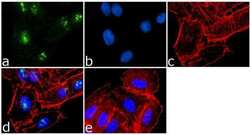
- Experimental details
- Immunofluorescence analysis of SRC1 was done on 70% confluent log phase A549 cells. The cells were fixed with 4% paraformaldehyde for 15 minutes, permeabilized with 0.25% Triton™ X-100 for 10 minutes, and blocked with 5% BSA for 1 hour at room temperature. The cells were labeled with SRC1 Rabbit Polyclonal Antibody (Product # PA1-840) at 1 µg/mL in 1% BSA and incubated for 3 hours at room temperature and then labeled with Goat anti-Rabbit IgG (H+L) Superclonal™ Secondary Antibody, Alexa Fluor® 488 conjugate (Product # A27034) at a dilution of 1:2000 for 45 minutes at room temperature (Panel a: green). Nuclei (Panel b: blue) were stained with SlowFade® Gold Antifade Mountant with DAPI (Product # S36938). F-actin (Panel c: red) was stained with Alexa Fluor® 555 Rhodamine Phalloidin (Product # R415, 1:300). Panel d is a merged image showing Nuclear localization. Panel e is a no primary antibody control. The images were captured at 60X magnification.
- Submitted by
- Invitrogen Antibodies (provider)
- Main image
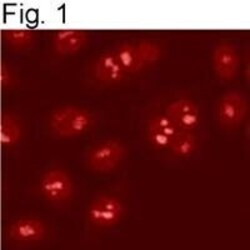
- Experimental details
- Immunolocalization of SRC-1 in HeLa cells using Product # PA1-840.
- Submitted by
- Invitrogen Antibodies (provider)
- Main image
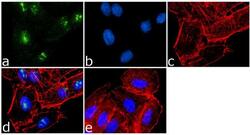
- Experimental details
- Immunofluorescence analysis of SRC1 was done on 70% confluent log phase A549 cells. The cells were fixed with 4% paraformaldehyde for 15 minutes, permeabilized with 0.25% Triton™ X-100 for 10 minutes, and blocked with 5% BSA for 1 hour at room temperature. The cells were labeled with SRC1 Rabbit Polyclonal Antibody (Product # PA1-840) at 1 µg/mL in 1% BSA and incubated for 3 hours at room temperature and then labeled with Goat anti-Rabbit IgG (Heavy Chain) Superclonal™ Secondary Antibody, Alexa Fluor® 488 conjugate (Product # A27034) at a dilution of 1:2000 for 45 minutes at room temperature (Panel a: green). Nuclei (Panel b: blue) were stained with SlowFade® Gold Antifade Mountant with DAPI (Product # S36938). F-actin (Panel c: red) was stained with Alexa Fluor® 555 Rhodamine Phalloidin (Product # R415, 1:300). Panel d is a merged image showing Nuclear localization. Panel e is a no primary antibody control. The images were captured at 60X magnification.
- Submitted by
- Invitrogen Antibodies (provider)
- Main image
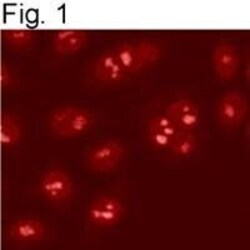
- Experimental details
- Immunolocalization of SRC-1 in HeLa cells using Product # PA1-840.
Supportive validation
- Submitted by
- Invitrogen Antibodies (provider)
- Main image
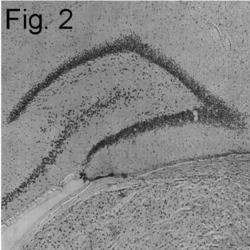
- Experimental details
- Immunohistochemical staining of SRC-1 in the Dentate Gyrus region of the rat brain using Product # PA1-840.
Supportive validation
- Submitted by
- Invitrogen Antibodies (provider)
- Main image
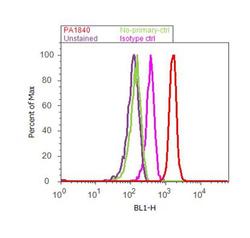
- Experimental details
- Flow cytometry analysis of SRC1 was done on HT-29 cells. Cells were fixed with 70% ethanol for 10 minutes, permeabilized with 0.25% Triton™ X-100 for 20 minutes, and blocked with 5% BSA for 30 minutes at room temperature. Cells were labeled with SRC1 Rabbit Polyclonal Antibody (PA1840, red histogram) or with rabbit isotype control (pink histogram) at 3-5 ug/million cells in 2.5% BSA. After incubation at room temperature for 2 hours, the cells were labeled with Alexa Fluor® 488 Goat Anti-Rabbit Secondary Antibody (A11008) at a dilution of 1:400 for 30 minutes at room temperature. The representative 10,000 cells were acquired and analyzed for each sample using an Attune® Acoustic Focusing Cytometer. The purple histogram represents unstained control cells and the green histogram represents no-primary-antibody control.
Supportive validation
- Submitted by
- Invitrogen Antibodies (provider)
- Main image
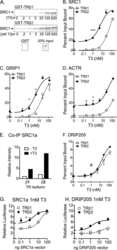
- Experimental details
- NULL
- Submitted by
- Invitrogen Antibodies (provider)
- Main image
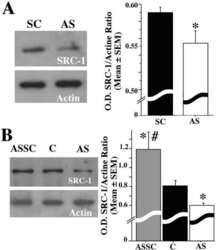
- Experimental details
- NULL
 Explore
Explore Validate
Validate Learn
Learn Western blot
Western blot Immunocytochemistry
Immunocytochemistry